Breakfast Do’s and Don’ts
By Sarah Hunt, AZFB Communications Intern
As we all know, breakfast is the most important meal of the day. It gives you the energy you need for your daily activities and gives you a great start to your morning if done right. Here are some tips to make the most of your breakfast.
- Add protein and fiber: This gives your meal what it needs to keep you full until lunch. Protein can come from many sources: eggs, greek yogurt, ham, bacon, sausage, beans, etc. Mix up your protein sources each day to give your diet variety. Adults with a 2,000 calorie daily intake should include 25 g of fiber. Fiber can come from many sources, including oatmeal, whole wheat bread, and nuts.
- Avoid sugar: One thing to be careful about with breakfast is sugar. Cereals, yogurts, muffins and baked goods, smoothies, and more all have a high content of sugar. If you only eat sugar and carbohydrates first thing in the morning, you will crash within the next hour and feel hungry even though you just ate. Replacing sugar with protein solves this problem.
- Check your nutrition labels: I used to love eating Chobani greek yogurt, thinking I was eating so healthy because of the high protein in it. Little did I know it had twice the amount of sugar in it than protein! I now eat Oikos greek yogurt. It has more protein and much less sugar, only 5 g per serving. It’s also the official yogurt of the NFL! If it’s too thick for you, add a little honey to thin it out and add flavor.
- Add fresh veggies or fruit: Vegetables for breakfast? Yes please! Some people may think, how do I put veggies in my morning meal? It’s actually pretty easy. Add potatoes, spinach, mushrooms, and onions to your omelets or make Huevos Rancheros with beans and pico de gallo. Fruit is another good thing to add. Bananas fill your potassium needs. Fruit gives you antioxidants and gives you something sweet and natural to eat instead of processed sugar.
- Eat a balanced breakfast: Don’t eat the same thing every day, and eat a variety of foods in your meal. This ensures you don’t get tired of one food and gives you the most nutrients to fill your daily needs. Additionally, eating all different colors of fruits and vegetables have many benefits. Learn more about this from Fill Your Plate’s article, Why You Should Be Eating The Colors of the Rainbow.
Learn more by typing “breakfast” into Fill Your Plate’s search engine!
Butternut Squash, Apple and Sausage Hash
By Blue Sky Organic Farms
Are you looking for a new recipe to spice up your summer? Try our butternut squash, apple and sausage hash! It’s a delicious way to get your fruits and vegetables in as well as some protein. Here’s some nutrition facts about the vegetables in this recipe.
One cup of butternut squash has 63 calories, 0 grams of fat, 16 grams of carbohydrates, 2.8 grams of dietary fiber, 3 grams of sugar, 1.4 grams of protein, and 6 milligrams of sodium (WebMD). It also gives you plenty of vitamin A, C, magnesium, potassium and calcium. It’s mostly water, so by eating it, it helps you stay hydrated. It also boosts eye health and immunity.
One cup of kale has 33 calories, nearly 3 grams of protein, 2.5 grams of fiber (which helps manage blood sugar and makes you feel full), vitamins A, C, and K, and folate, which a B vitamin that’s key for brain development (WebMD).
We hope you enjoy this recipe and share it with all your family members and friends! Don’t forget to get your vegetables straight from Arizona farms by using the Find a Farm Product database on Fill Your Plate’s website!
Butternut Squash, Apple & Sausage Hash
Serves 6
- 1 lb. bulk breakfast sausage
- 2 TBSP olive oil
- 1 butternut squash ~ peeled and seeded; ¼ inch diced * (or any dense sweet squash)
- 1 medium onion ~ diced
- 1 apple ~ cored and diced
- 1 bunch of kale ~ stems removed and torn into pieces
- 6 TBSP of broth or water ~ divided
- 1 tsp chopped garlic
- 1 tsp salt
- ½ tsp black pepper
- 4 oz Crow’s Dairy Goat Milk Feta ~ drained and crumbled
Instructions:
- In a large skillet cook sausage until no longer pink. Remove from pan and keep warm.
- In the same pan heat 2 TBSP olive oil.
- Add in butternut squash (or any dense sweet squash) and onion. Sauté over medium heat for 8 minutes.
- Add in 4 TBSP of stock, cooked sausage, apple, garlic, salt and pepper. Sauté for 2 – 3 minutes.
- Add kale and remaining stock. Cover and let kale wilt.
- Remove from heat and top with crumbled feta.
- Serve immediately.
Recipe by Chef Danielle Kitchens
Fresh Tip: Get a pint glass jar, add one inch of clean water. Snip off 1/4” from the bottom of the herbs, put in jar and cover with a clear plastic bag. I made sure no leaves were below water level. Put in fridge, change water every couple of days, picking out the yellow leaves if any.
Roasted Fennel and Carrots
By Blue Sky Organic Farms
Looking for a delicious new combination of roasted veggies to add to your dinner table? Try roasted fennel and carrots!
Carrots have multiple health benefits. They are full of fiber, antioxidants, and potassium. They can also help people lose weight, have healthier eyes, and lower cholesterol.
Fennel is another good source of fiber, as well as carbohydrates and potassium. It can improve bone health, immunity, blood pressure, and heart health, to name a few.
Make sure to get the freshest vegetables for your roasted fennel and carrots from one of our many Arizona farms using Fill Your Plate’s Find a Farm Product database, which includes Blue Sky Organic Farms, who supplied this recipe!
Ingredients:
1 bunch baby fennel
1 bunch purple spring onions
1 bunch spring carrots
1 T. white balsamic vinegar****
1 T. olive oil
1 tsp. chopped garlic
1/2 tsp. salt
1/4 tsp. black pepper
Directions:
- Preheat oven to 400* 2. Remove tops from fennel. Cut fennel bulbs in half top to bottom and them cut each piece in half. 3. Remove tops and bottoms from onions and quarter the onions. 4. Peel carrots and cut into sticks. 5. Add veggies to a bowl and add remaining ingredients and toss to coat. 6. Place veggies on a parchment lined sheet pan. 7. Roast veggies for 30 – 40 minutes or until fork tender. 8. Serve immediately. ****you can substitute white wine vinegar for the white balsamic vinegar.
Succotash
By Blue Sky Organic Farms
Okra and field onions are in season right now, making it the perfect time to make succotash, a delicious side dish.
Onions contain 89% water, making them an excellent supplement for hydration. They are low in sugar and fat, have small amounts of protein, are full of flavor, and have 9.3 grams of carbs.
Okra contains nutritional essentials such as vitamins A, C and K1, as well as folate, magnesium, antioxidants, and fiber. It can be helpful to keep blood sugar under control, aid pregnancies, and maintain a healthy heart.
Make sure to get the freshest vegetables for your succotash from one of our many Arizona farms using Fill Your Plate’s Find a Farm Product database, which includes Blue Sky Organic Farms, who supplied this recipe!
Succotash
(Serves 6 – 8)
- 6 slices of bacon
- 2 c corn ~ fresh or frozen
- 2 c of lima beans ~ frozen
- ½ medium onion ~ diced
- 1 orange bell pepper ~ cored and diced
- 1 jalapeno ~ seeded and diced small
- 8 oz okra ~ trim ends and slice into 1/4″ pieces
- 6 oz cherry tomatoes ~ quartered
- 1 TBSP apple cider vinegar
- 1 tsp chopped garlic
- 1 tsp paprika
- 1 tsp salt
- ½ tsp black pepper
Instructions:
- Dice bacon and cook over medium heat until crisp. Remove from skillet and drain on a paper towel lined plated. Discard all but 3 TBSP of bacon grease.
- If using frozen corn and lima beans defrost.
- In the skillet with the bacon grease add the onion, bell pepper, jalapeno and okra. Cook for 5 – 6 minutes or until soft.
- Add corn, lima beans, garlic, apple cider vinegar, paprika, salt and pepper. Sauté for about 8 minutes.
- Add in tomatoes and bacon and cook for 2 more minutes.
- Serve immediately.
***Recipe Notes:
- If you cannot find lima beans, you can substitute with edamame.
- You can substitute red or white wine vinegar for the apple cider vinegar.
- For vegan version sauté in olive oil
The Art of Salad Making
By Sarah Alinejad a recent ASU Nutrition Student

I’m not going to beat around the bush. This article is about salads. When I first started making salads, I didn’t think there was much to it besides cutting some lettuce and vegetables and tossing them in a bowl with salad dressing. Really, what else could there be?
Well, there could be a lot more, actually. So much more, that this salad-changing information will switch up the entire salad game and make it so you’ll actually want to eat them. Summer is right around the corner and that means there’s going to be plenty of seasonal produce available, which means exciting salads full of beautiful colors.
But, first, you need to know how to make a salad. It may seem simple, but maybe that’s the issue. They’re simple. Boring. Comparable to the color khaki. They just kinda make you wince and yearn for it to be anything else.
My bet is that you don’t actually know how to make a salad, so I’m going to tell you how. Making a great salad is an art and the trick is to treat every ingredient as if you’re eating it individually. These are tips for making any kind of salad, but I have added my all-time favorites below.
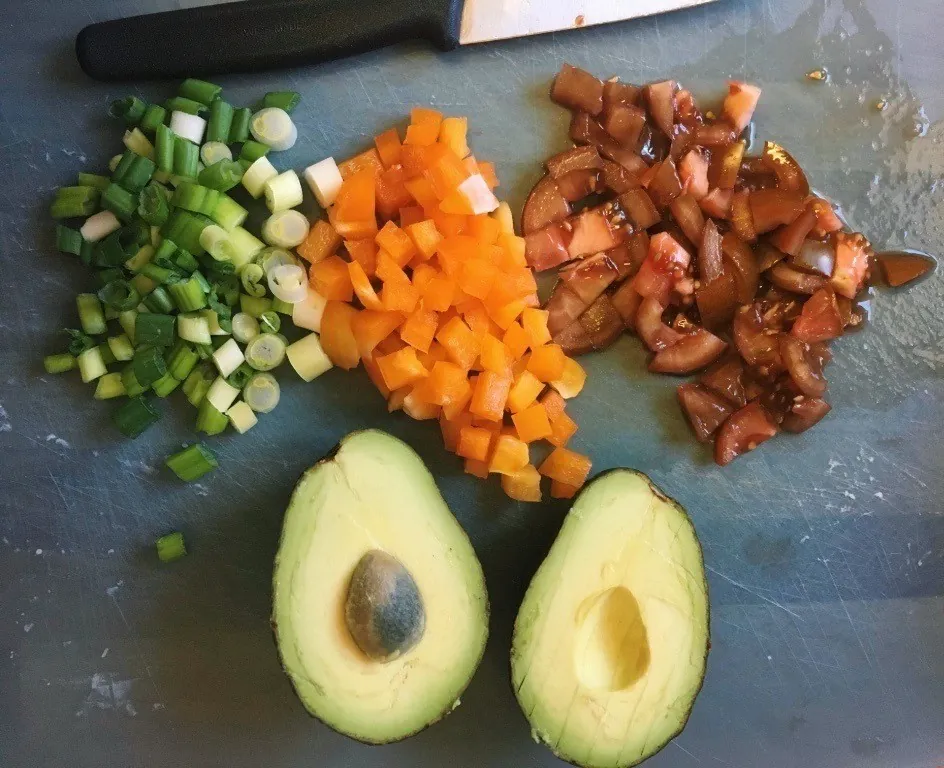
- Don’t settle for solely butter lettuce. Chop up some romaine or chiffonade some spinach. Arugula and baby mixed greens are also a good option for a flavor variety. If you decide to do kale, massage and sauté it for a couple minutes before adding it in. Try all the types of greens and note which ones are your favorites. (Pro tip: the darker the leaf, the higher the vitamin content.)
- They are so important. Chop some up and throw it on. Basil, dill, cilantro, green onion, and parsley are all great options.
- Don’t be afraid of adding fruit! Fruit in salads are amazing and should be treated as such. Watermelon, strawberries, apples, pomegranate seeds, and oranges are refreshing and provide a contrasting flavor.
- Raw veggies can be chopped into large chunks or tiny pieces. Some, like zucchini and carrots, can be spiraled or shredded, and others, like tomatoes, and bell peppers, sliced. Throw in some corn, green beans, radishes, or cucumbers. Get a good mix of veggies in there. It’s important to add some flavor to them, even if it’s just some lemon, salt, and black pepper.
- You also have the option to add cooked veggies, like steamed broccoli, sautéed kale, or roasted potatoes. This is also a great chance to clean out the fridge and throw in any veggies that might need using up.
- Add some legumes or a faux meat for a hearty, protein-packed salad. This could be lentils, white beans, edamame, chickpeas, tofu, or a some kind of plant-based meat alternative.
- Add some toppings! A few croutons, nuts, seeds, or pickled onion add a whole new dimension to your salad. Avocados and olives are also a favorite addition.
- Last but not least, dress your salad. But don’t drown it either. Add some dressing and toss (or shake, if you have a lid) and if you need to add some more, add a little more. Dressing should be added gradually, otherwise it’s easy to get carried away and you’ll be wishing you had more salad for your dressing.
- Be creative! Try different salads and note your favorite flavors and ingredient combinations.
Stone Strawberry Salad
This is a salad created by my boyfriend that he shared with me when we first started dating. Now, it’s our go-to salad since we almost always have the ingredients in the house.
Ingredients:
Spring mix (use however much you’d like, but your greens should be a hefty part of any salad)
4-5 strawberries, sliced
1 green apple (or other stone fruits like pear, plum or apples), sliced
1 carrot, coined
2 celery stalks, chopped
2 Persian cucumbers, coined
1 avocado, sliced
1/4 walnuts (optional)
~2 tbsp Briana’s Poppyseed Dressing (I kinda cheated here—I haven’t found a poppyseed dressing recipe quite comparable to Briana’s. I’m working on it.)
Directions
- Wash all produce thoroughly.
- Chop and slice the strawberries, green apples, carrot, and cucumber.
- Throw the it in a bowl.
- Add rinsed spring mix on top.
- Slice avocado and add on top salad. Add walnuts (optional).
- Dress and eat!
Summer Veggie Roll Salad with Peanut Dressing
Once I learned how to make fresh summer rolls, I became a little obsessed. I started doing it a lot because I loved eating these little rice rolls filled with crunchy veggies and dipped in a savory-sweet peanut sauce. I seriously couldn’t get enough of them. The problem with these summer rolls though, is the amount of prep work they are. There’s a lot of produce to chiffonade, julienne, and chop, not to mention the tedious work of wrapping it all into a paper-thin (no really, it’s rice paper) roll. So, I found a way to skip the labor intensive parts while still keeping all the flavors.
Salad ingredients:
1/4 head Boston lettuce, shredded
1/4 head romaine, shredded
1 cup spinach, shredded
1 carrot
1 bell pepper
1 Persian cucumber
1/4 bunch mint, shredded
1/4 bunch cilantro, shredded
1 avocado, sliced
1/4 cup peanuts (optional)
Directions
- Wash all produce thoroughly.
- Chop or slice carrot, bell pepper, and cucumber.
- Chiffonade the Boston lettuce, romaine, spinach, mint, and cilantro.
- Throw everything in a bowl together.
- Slice avocado and add on top salad. Add peanuts (optional).
- Dress and eat!
Peanut dressing ingredients:
2 tbsp peanut butter
3 tbsp Hoisin sauce
1 clove garlic, minced
1 tbsp brown sugar
1/2 tbsp chili powder
warm water (for thinning)
Directions
- Mix peanut butter, Hoisin, and 1 tbsp warm water. Stir thoroughly.
- When the mixture starts to thin out, add garlic, brown sugar, and chili powder.
- Use warm water 1 tbsp at a time as needed to make a thinner or thicker dressing (depending on your preference).
- Add to salad.
Kale Cesar Salad
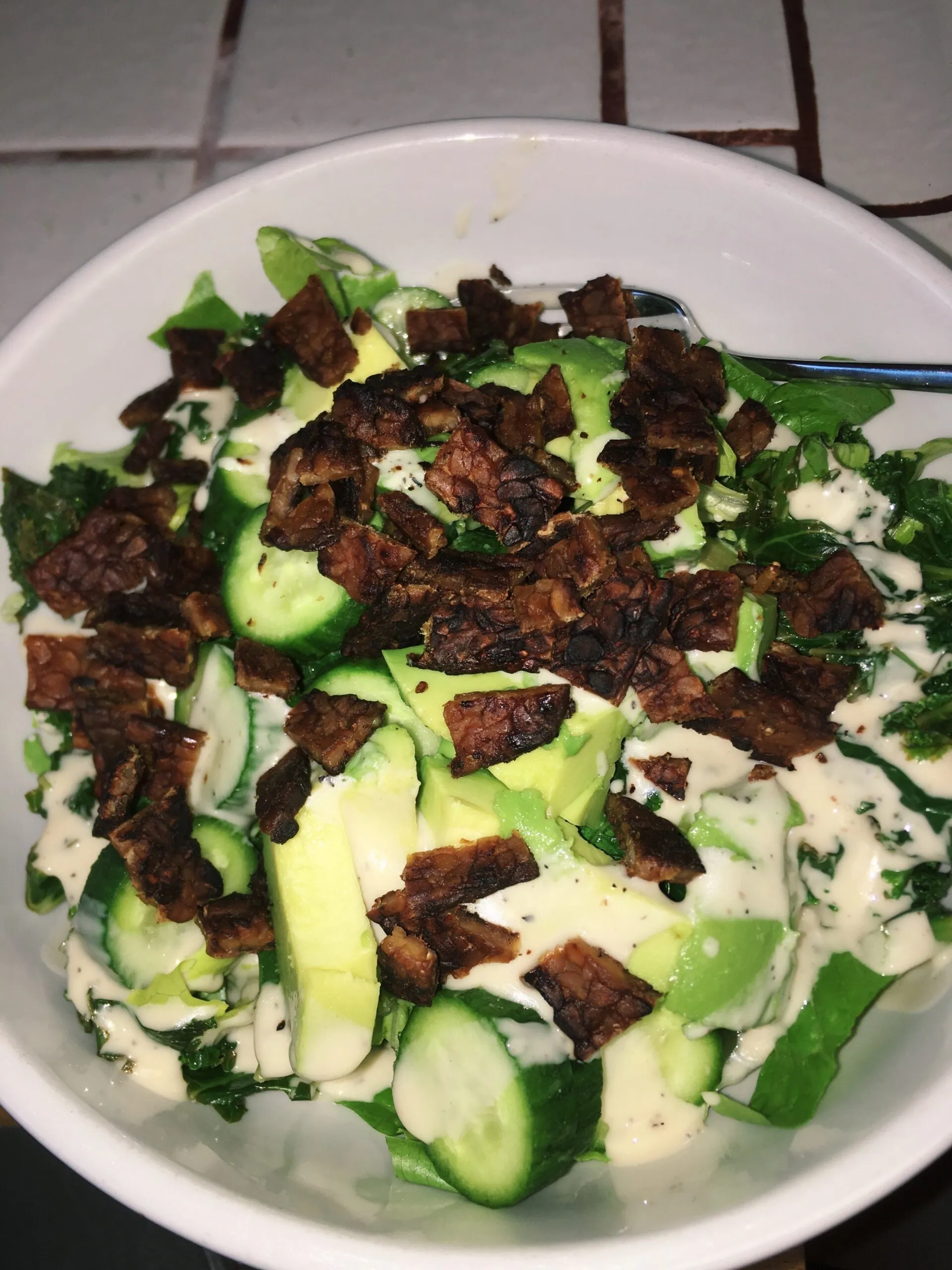
One of my favorite salads, inspired by Veggie Grill. Comforting, simple, and easy.
Ingredients:
1/2 head romaine lettuce
1/2 bunch kale, sautéed
2 strips Lightlife Smoky Tempeh Strips
2 Persian cucumbers
1 stalk celery
1 avocado
2 tbsp olive oil
1/4 tsp salt
~2 tbsp Minimalist Baker Cesar dressing
Directions
- Wash all produce thoroughly.
- Chop and slice romaine, kale, celery, and cucumber.
- Heat a medium pan over medium heat. Add 1 tbsp olive oil.
- Add kale and salt. Allow to sauté for about 3-4 minutes.
- When kale is partially wilted, remove from heat and set aside.
- Reheat pan to medium heat and add tempeh. Allow each side to cook, about 3-4 minutes.
- When tempeh is done, drain it on a towel and allow it to cool.
- Once tempeh is cool, crumble it up for the salad topping.
- Throw romaine, sautéed kale, cucumber, and tempeh in a bowl.
- Slice avocado and add on top salad.
- Dress and eat!
Crunchy Thai Salad with Thai Peanut Dressing
My own take on a Thai salad with some crunch. Trader Joe’s prepackaged salad got nothin’ on this.
Ingredients:
1 cup romaine, shredded
1 cup cabbage, shredded (purple is prettier but green is fine)
1/2 cup edamame (frozen is fine, but if you have fresh, that’s great too)
1 Persian cucumber, sliced
1 zucchini, spiraled
1 carrot, spiraled or shredded
1/4 cup cilantro, shredded
1/4 cup crunchy rice noodle
1 scallion, sliced
1 lime
Directions
- Wash all produce thoroughly.
- Chiffonade romaine and cilantro.
- Slice cabbage (finely) and slice cucumber and scallion.
- Spiral zucchini and carrot.
- Throw everything in a bowl together.
- Slice avocado and add on top salad. Add crunchy rice noodle.
- Squeeze lime on salad and add scallions.
- Dress and eat!
Thai peanut dressing ingredients:
2 tbsp peanut butter
3 tbsp Hoisin sauce
1 tbsp sesame oil
1 clove garlic, minced
1 tbsp brown sugar
1/2 tbsp chili powder
1 lime, juiced
warm water (for thinning)
Directions
- Mix peanut butter, Hoisin, sesame oil and 1 tbsp warm water. Stir thoroughly.
- When the mixture starts to thin out, add garlic, brown sugar, and chili powder and lime juice.
- Use warm water 1 tbsp at a time as needed to make a thinner or thicker dressing (depending on your preference).
- Add to salad.
These are just a few of my go-to’s. They’re some of the easier and more simple ones, but I (almost) always have the ingredients around. They’re packed with vitamins, minerals, fiber, and water and without fail, I always feel good afterward. Content but not stuffed and bursting with energy. I admit it took me some time to accept salads, but when I sat down and got the chance to know them, I realized they weren’t so bad after all. The word ‘salad’ itself just sounds boring because we’ve only ever had boring salads, but all they need is a little understanding and encouragement. Salads will be whatever you make them, so start experimenting with new flavors, colors, fruits, veggies, herbs, and greens. Chances are you’ll discover something incredible. It’s time to do a little Pavlovian reconditioning and give our new and improved salads the credit they deserve.
Are Superfoods Superfake?
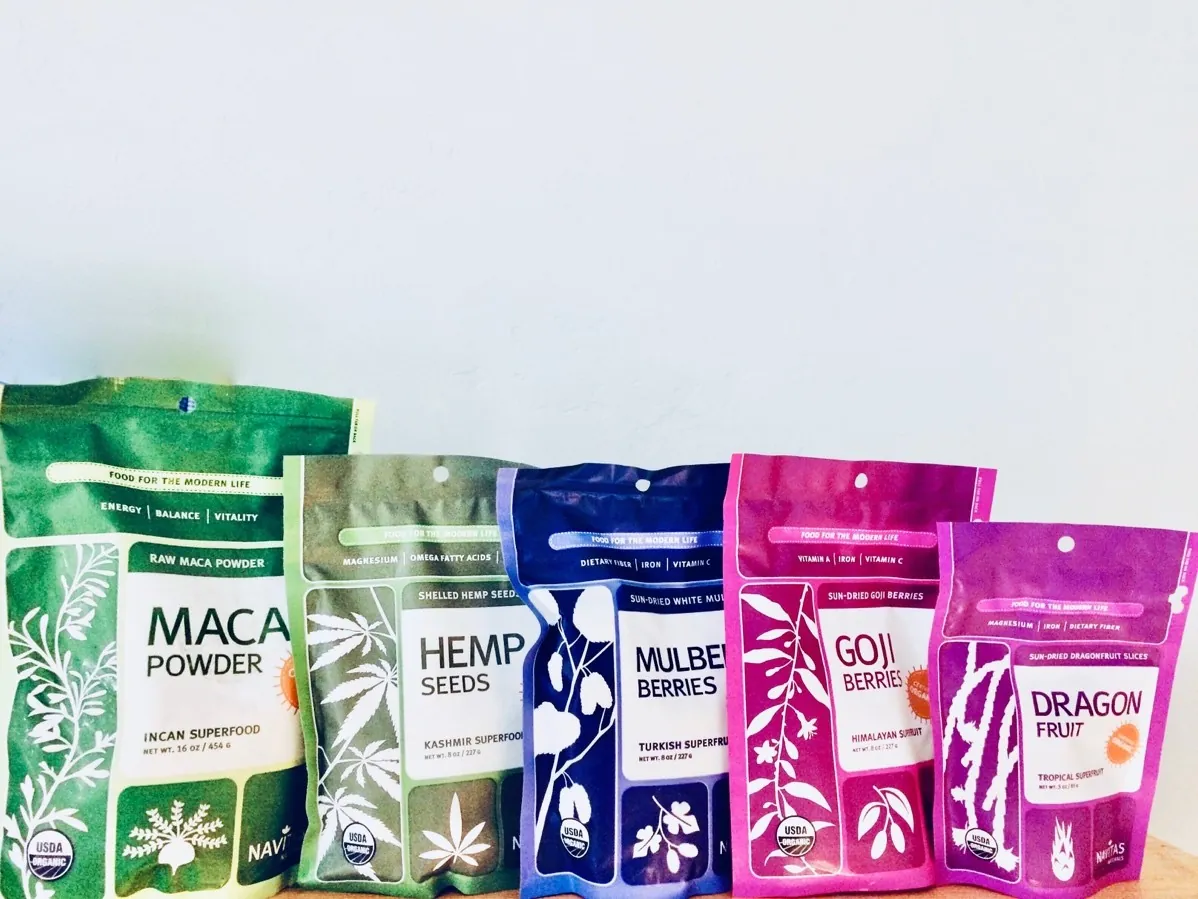
Image by Sarah Alinejad
Sarah Alinejad a recent ASU Nutrition Student
If there was a certain food that contained a plethora of vitamins and minerals, including high levels of vitamin C and A, vitamins B6, K1, and E, folate, potassium, and contained only few calories, some might call it a superfood. If I said that food was a bell pepper, some might be less impressed. “Superfoods” are thought of as exotic and unique—the be-all-end-all of healthy foods. What we don’t realize is that there are a lot more “superfoods” out there than we realize. They just aren’t touted as such. Why is that?
This impression of them is intentional done by marketing campaigns and is also a result of culinary colonialism. There’s this hyper focus on a specific property or nutrient of the food and because of this, justifies a higher price point. What isn’t recognized is that these foods have actually been around for centuries in their native cultures. They have cultural significance and meaning—however, that is erased and rebranded to appease western markets, which claim to value health so much.
Breaking food down to its simpler components is one way to decipher if it’s healthy or not. If something has high levels of saturated fat, best to stay away from it, while something with more fiber would be a healthier option. Something with high levels of antioxidants and phytochemicals would be healthier than a highly processed food that was depleted of valuable nutrients. However, this should be considered guidelines only because this can turn into a very gray area very quickly and teeters on reductionism. Reductionism can be useful, but doesn’t consider the whole picture, which tends to be more beneficial in the long run.
Another point worth noting is companies may use a “superfood” in their product, but it’s an incredibly refined version of that, to the point where the beneficial nutrients may have been removed. For example, açaí puree may be present in a food product, but combined with tons of added sugar. Juices contain lots of vitamins, but filter out other beneficial properties that a whole food would otherwise have, such as fiber and water. This doesn’t always invalidate the potential health benefits, but realizing a refined product and a whole product have significant differences creates a clearer picture on the implications of said food product.
Some of these “superfood” trends within the past few years have been açaí berry, matcha, and kale. They’ve been so popular because of their high antioxidant levels—specifically polyphenols, which are known to improve a variety of health issues such as diabetes or heart disease. The harsh reality is, there is no such thing as a “superfood”. It’s another word on the list of marketing terms that was created to help sell products. In fact, all whole foods, such as fruits, vegetables, whole grains, legumes, and nuts or seeds contain vast amounts of nutrients, all in varying degrees. This includes herbs and spices, which have also been known to be useful in Eastern medicine.
Don’t get me wrong—the movement towards healthier snacking has good intentions. The shift in wanting to eat healthier has created many opportunities, from new product ideas to culinary creation, and my guess is that it’ll continue that way as people continue to become more aware of their eating habits.
So to sum it up, yes, these “superfoods” individually contain high amounts of beneficial things like high levels of vitamin C and antioxidants. However, our bodies don’t run solely off those micronutrients. Our bodies are so much more complex and they need complex carbohydrates, sufficient amounts of protein, and healthy fats. That being said, balance is absolutely essential when it comes to a healthy diet. (Really, balance is essential when it comes to almost anything).
Açaí and matcha are great to incorporate into the diet, but also not necessary for one to be healthy, nor are they the answer to every health ailment. It’s also important to remember that these foods existed in their own cultural worlds, outside a western, capitalistic society and should be paid homage as such. We can and should still enjoy and appreciate these unique types of foods, keeping in mind that there’s more to them than fake buzzwords and pretty packaging.
Sweet Potato Gnocchi with Vegetables
By Gabrielle Hungate a recent ASU Nutrition Student
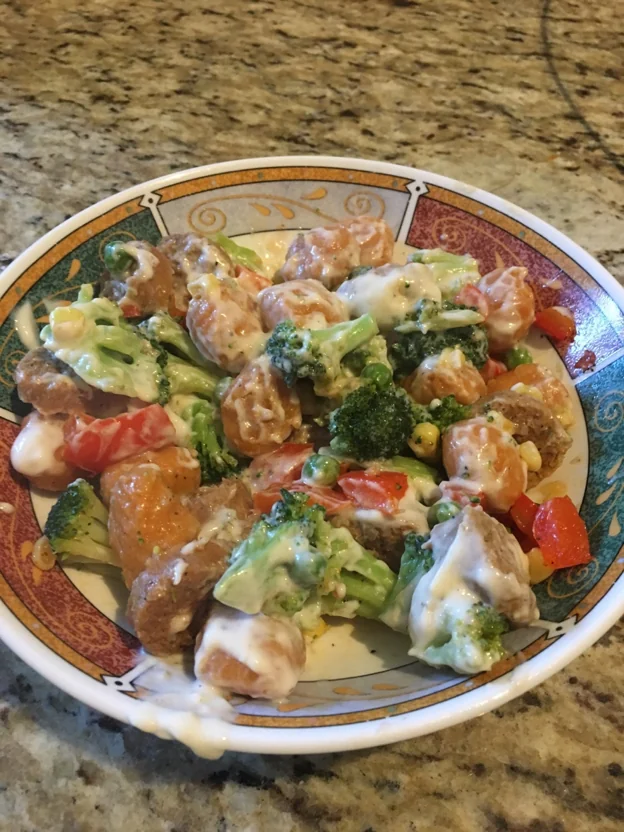
This is a recipe that is something that has become a staple in my home. It is can be made, gluten, free, and vegan or vegetarian. It has all of the right components, such as texture, flavor, protein, fiber, and carbohydrates. The gnocchi can be made homemade or packages, although homemade is recommended.
Sweet Potato Gnocchi
2 (8 ounces) sweet potatoes
1 clove garlic, pressed
1/2 teaspoon salt
1/2 teaspoon ground nutmeg
1 egg
2 cups all-purpose flour(or gluten-free flour)
Preheat the oven to 350 degrees F (175 degrees C). Bake sweet potatoes for 30 minutes, or until soft to the touch. Remove from the oven, and set aside to cool.
Remove the peels, and mash them, or press them through a ricer into a large bowl. Blend in the garlic, salt, nutmeg, and egg. Mix in the flour a little at a time until you have a soft dough. Use more or less flour as needed.
Bring a large pot of lightly salted water to a boil. While you wait for the water, make the gnocchi. On a floured surface, roll the dough out in several long snakes, and cut into 1-inch sections. Drop the pieces into the boiling water, and allow them to cook until they float to the surface. Remove the floating pieces with a slotted spoon, and keep warm in a serving dish. Serve with butter or cream sauce.
Vegetable Mixture
1 head of broccoli chopped
2 Red Pepper chopped
2 vegetarian or traditional sausages
1 cup of organic corn
1 cup of organic peas
Saute mixture with 1 tablespoon of olive oil and add salt and pepper for tasting. Add in gnocchi and add in tomato sauce, pesto or alfredo sauce. All sauces are a great addition!
What to Eat Before Running
By Jennifer Restuccio a Recent ASU Nutrition Student
So, as you can imagine, I have no idea what I need to do to be able to run this marathon which is about one year away at the time of writing this. So, I did some research. I was fascinated with the science behind sports nutrition.
Your pre-run meal can either make or break your workout. A perfectly planned pre-run meal will fuel your body with exactly what it needs to power through those tough moments. Eating before running helps control hunger and ensures optimal blood sugar levels.
My big question is, “What should I eat before running?”.
The goal is to keep it simple. Don’t eat a heavy meal right before your workout. You want to consume foods that you digest easily and quickly.
The perfect pre-run snack is a reasonable volume, low in fiber, low in fat, has some protein, and is high in carbohydrates. The main thing you need right before a workout is carbohydrates.
In addition, make sure you stay hydrated before a run. It’s best to drink at least 20 ounces of water 1-2 hours before running.
Keep in mind that if you are running for less than 60 minutes at a relaxed pace, you might just need a glass of water beforehand.
Here are some examples of snacks you can eat 30-60 minutes before a run. Eat a banana, a slice of toast, half a cup of dry cereal, or half of a sports energy bar.
Personally, my favorite pre-run snack is a baked sweet potato about 45 minutes before my run.
What you eat before running is important, but it’s also important when you eat. You don’t want to be running on empty, and you also don’t want to be running on a full stomach (YIKES).
If you run on a full stomach you might experience a cramp in your side.
Runners call that a side stitch. Side stiches can happen from eating too much before a run, too soon before a run, or drinking too much water before or during a run.
If you’re eating a full meal, it should be eaten 3-4 hours before running.
Eating a meal 3-4 hours before running is especially important for long-distance runners.
An example of a pre-run meal is 5 scrambled egg whites, 1 whole egg, two slices of white toast with jelly, and 1 banana. Or you could try 1 white bagel with 2 slices of turkey and about 30 grapes. Notice that these meals are substantially larger than the snacks mentioned above and contain moderate amounts of protein.
If all of this confuses you, don’t worry. I’ve broken it down into 2 basic rules.
The bottom line:
Snacks = 30-60 minutes before running, high carb
Meals = 3-4 hours before running, high carb, moderate protein
As it turns out, the gargantuan task of running a marathon doesn’t require an equally formidable meal prep strategy. Don’t over think it, keep it simple, and take it one step at a time.
Sources:
https://www.runnersblueprint.com/gi-distress-running-prevention/
https://www.runnersblueprint.com/nutritious-prerun-meals-and-snacks/
https://www.healthline.com/nutrition/what-to-eat-before-running#pre-run-snack
Looking for more fun articles? Check out the Fill Your Plate blog for new articles every week. For fun recipes to cook with the family, be sure to check out the Fill Your Plate recipe section.
50 Ways to Enjoy Arizona Pecans
By Jennifer Restuccio a recent ASU Nutrition Student
Arizona has some of the best fruits and nuts in the world. Dates, pecans, pistachios, and lemons are all coveted Arizona exports. In 2018 alone Arizona’s pecan production was worth over 52,170,000 dollars and 17,000 acres were used for harvesting pecans.
Pecans are a holiday favorite, but there is so much more than just pecan pie. If you have some pecans on hand and you’re feeling creative, here are some delicious recipes that break the mold.
If you aren’t a fan of pecans, let me remind you that they are a great source of protein, fiber, and healthy fats. Pecans are also high in vitamin E, vitamin A, folic acid, iron, and magnesium. Give one of these recipes a try and I guarantee you will fall in love with the rich nutty flavor of pecans.
Scientific evidence even suggests that eating a handful of nuts a day helps lower cholesterol and can reduce the risk of developing heart disease as if you needed even more reasons to incorporate pecans into your diet.
Here are 50 unique recipes that will make you see pecans in a whole new light!

- Mini Pecan Monkey Bread Loaves
- Pecan Rice
- Slow Cooker Candied Nuts
- Grape Pecan Chicken Salad
- Carrot Pecan Cake
- Pineapple Pecan Cheese Ball
- Just Like LongHorn’s Strawberry Pecan Salad
- Pecan Tassies
- Pecan Raisin Bread
- Green Beans with Candied Pecans
- Alaska Salmon Bake with Pecan Crunch Coating
- Pecan Snowball Cookies
- Apple Pecan Cobbler
- Prickly Pear Pecan Bars
- Papaya Pecan Streusel Cake
- Maple Pecan Granola
- Millionaire Pie
- Baked Blueberry Pecan French Toast
- Southern Pecan Pie Coffee Cake
- Turtle Candy with Pecans and Caramel
- Cranberry Apple Pie with Pecan Shortbread Crust
- Pecan Meringue Cookies
- Roasted Brussels Sprouts with Bacon Pecans and Maple Syrup
- Homemade Basil Pecan Pesto
- Pecan Crusted Pork Tenderloin
- Mama’s Sausage Pecan Balls
- Spaghetti and Pecan Meatballs
- Brown Butter Chocolate Chip Cookies
- Lentil Pea and Potato Curry
- Pecan Sweet Potato Bake
- Easy Banana Pecan Bread
- Pecan Chicken Casserole
- Chili Pecans
- Pan-Roasted Steak Pasta with Pecans
- Pear and Bleu Cheese Salad
- Chai Spiced Blackberry Muffins with Pecan Oat Streusel
- Cranberry Pecan Stuffing
- Pecan Smoked Chicken Wings
- Pecan Jam
- Louisiana Pecan Bacon Bread
- Apricot Pecan Cornbread Stuffing
- Oatmeal Pecan Muffins
- Pecan Crusted Tuna Steak
- Pumpkin Pecan Frozen Yogurt
- Berry-Pecan Cheesecake Bars (Keto)
- Wheat Berry Salad with Pecans and Craisins
- Clean Eating Butternut Pecan Quinoa Salad
- Candied Pecan Pear Salad with Pomegranates
- Pecan Applewood Smoked Turkey Breast
- Creamy Lentil and Pecan Cucumber Toppers
Sources:
https://ilovepecans.org/nutrition-in-a-nutshell/
https://agriculture.az.gov/plantsproduce/what-we-grow/tree-fruits-and-nuts
https://www.nass.usda.gov/Quick_Stats/Ag_Overview/stateOverview.php?state=ARIZONA
Looking for more fun articles? Check out the Fill Your Plate blog for new articles every week. For fun recipes to cook with the family, be sure to check out the Fill Your Plate recipe section.
What is Calorie Density
By Kenda Hettinger a Recent ASU Nutrition Student
When I first had my daughter in 2014, I kept 30 pounds of my excess weight for about a year. Then I stumbled across an article on calorie density and started to make small changes to my diet. The excess weight slipped off and I began to feel really good.
Learning about calorie density shouldn’t only be for those looking to lose weight. Most of the low-calorie dense foods are the most nutritious and fiber-filled foods you could eat. A meta-analysis completed in 2018 suggests that higher intake of fiber could help protect you against cardiovascular disease, type 2 diabetes, and pancreatic cancer.
What is calorie density?
The calorie density of a food is the measure of how many calories are in a given weight or volume of food. One hundred grams of spinach contains 24 calories and tons of vitamins, minerals, and fiber. One hundred grams of McDonald’s french fries contain 323 calories and lots of saturated fat. Which one is better? By the way, 100 grams of spinach is about 5 cups and 100 grams of McDonald’s french fries is less than their medium serving.
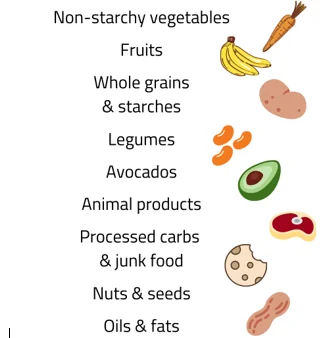
Benefits of eating low-calorie density.
When you eat at a low-calorie density, you tend to:
- Eat less processed foods
- Eat leaner meats
- Consume more vitamins and minerals
- Reduce your calorie intake
How to eat with calorie density in mind.
- Eat when you are hungry and eat until comfortably full.
- When eating, start with a low-calorie food such as soup or salad.
- Avoid high-calorie drinks, these do not fill you up.
- Oil is the highest in calories, watch out for hidden oil in your food.
- When making your plate, fill it mostly with vegetables and fruits and accessorize with the higher calorie-dense foods.
- Avoid high fat condiments.
- Some fats, such as avocados, seeds, and nuts are healthy and your body needs these but they should still be consumed in moderation.
The following illustration lists different food categories in order of least calorie-dense to most calorie-dense. There is some overlap of the different food categories, but it is trivial. In general, you should eat mostly towards the top and much less towards the bottom.
In conclusion
Eating with calorie density in mind is an easy way to control weight and eat a healthful diet. There is no calorie counting or restriction of the low-calorie foods.
Resources
Veronese, N., Solmi, M., Caruso, M., Giannelli, G., Osella, A., Evangelou, E., Tzoulaki, I. (2018). Dietary fiber and health outcomes: An umbrella review of systematic reviews and meta-analyses. The American Journal of Clinical Nutrition, 107(3), 436-444.
25 Really Fun Facts about Root Vegetables
Julie Murphree, Arizona Farm Bureau Outreach Director
We’re all about root vegetables. And, we have a lot to tell you about root vegetables. Here, we share some fun facts!
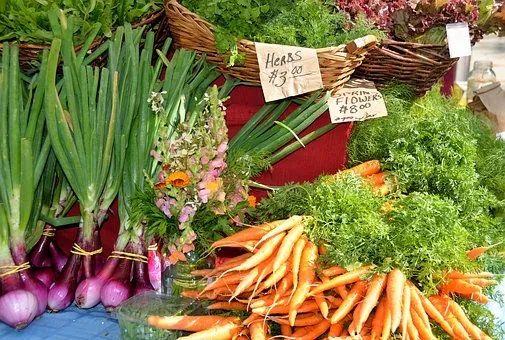
- Arizona grows nearly every kind of root vegetable that exists.
- The root vegetables are considered some of our best mix of vegetables to produce in the fall and winter months in Arizona.
- Obviously, these are all vegetables that grow below the ground.
- Technically, they’re not all roots, for example, onions and garlic.
- Root vegetables are low in calories and high in antioxidants.
- Each type of root vegetable contains a wide variety of vitamins and minerals.
- A medium baked russet potato (including its skin) has 164 calories and 935 mg of potassium (more than twice the potassium of a medium-sized banana).
- A cup of mashed turnips has 51 calories and 76 milligrams (mg) of calcium — as much calcium as half of a slice of cheddar cheese.
- The flesh of a medium baked sweet potato has only 103 calories and enough vitamin A — 1,096 micrograms (mcg) — to meet your entire Recommended Dietary Allowance for the day (for adults 51 or older, that’s 700 mcg for women, 900 mcg for men). Carrots are also a good source of vitamin A, with 1,069 mcg in a cup of chopped raw carrots.
- Carrots are best known for being rich in beta carotene, a compound that may reduce heart disease and certain types of cancer, and Vitamin A, which bolsters vision, bone growth and tooth development.
- Originally, wild carrot varieties ranged in color from white to purple.
- In the 1600s, Dutch agriculturalists developed carrots that emphasized orange tints and phased out purple. The tinkering didn’t stop there: Researchers at Southern Illinois University report that the British developed high-carotene carrots during World War II in order to enhance pilots’ night vision. Today, geneticists are breeding carrots in a wide color spectrum, including purple, red and yellow, all with slightly different nutritional properties.
- High in fiber, vitamin C and folate, parsnips make a nutrient-rich alternative to the potato when mashed or roasted as a side dish. Look for small- to medium-sized roots; larger parsnips can be woody.
- The average American eats 120 to 126 pounds of potatoes per year, and while Super-Size fries may have a lousy nutritional reputation, don’t blame the spud itself: fresh potatoes have more potassium than bananas as mentioned earlier, spinach or broccoli and are full of fiber and Vitamin C.
- There are as many ways to prepare potatoes as there are pots to cook them in, and they’re so cheap that there’s no reason you can’t experiment.
- One of the best things about beets is that they’re high in folic acids, which protect against birth defects.
- Fresh beets offer more than just crunch and a variety of colors — the greens attached to the beets are also tasty and can be sautéed with garlic and some olive oil and be eaten just like spinach or used in soups to provide some extra texture and nutrition.
- Claims that garlic prevents cancer and lowers cholesterol have been challenged.
- Garlic is delicious. Cut off the top, drizzle with olive oil, wrap in tin foil, and roast at 400 degrees until the cloves (only 4 calories apiece) are soft and spreadable.
- Root vegetables, including the onion, even have a place in the cocktail world. A Gibson is one of the few cocktails that’s garnished with an onion.
- Probably to all the wonderful flavor they contribute to a recipe, Americans consume about 20 pounds of onions per capita every year.
- A serving of onion has only 45 calories and can transform the taste and aroma of casseroles, sautés, salads and sandwiches — and just about anything else.
- Rutabagas are considered a cabbage-turnip hybrid. They’re easy to grow and, once you pull them from the ground, they can keep in your cupboard for up to three whole months. The big, yellow root vegetables have a stronger, more peppery flavor than their mild-mannered turnip cousins, and have more vitamin A and beta carotene, as well.
- More and more, cooks and chefs are turning the turnip into a more popular root vegetable. Often, they’ll blend turnips into their next batch of mashed potatoes. Turnips have a sweet flavor and plenty of vitamin C.
- Root vegetables are not always as popular with kids but when blended with their favorite vegetables, parents can introduce the little ones to new flavors.
Arizona Farm Bureau’s Fill Your Plate has a variety of vegetable recipes that include the root vegetables. Check out the recipes that mainly come from our Arizona farmers and ranchers.
Healthy Dips to Serve at Your Next Gathering
By Sarah Beleski a recent ASU Nutrition Student
We all love a good food spread at a party. In more recent years, I’ve found myself getting bored with the usual dips and snacks that I’m used to bringing or enjoying at a gathering. Guacamole, hummus, and taco dip are all delicious, don’t get me wrong, but I wanted to try something different.
I was also searching for healthier snack ideas that didn’t get pushed to the back corner of the table at a party… you know the ones I’m talking about. The “healthy” option that someone brought and now you feel obligated to put it on your plate but don’t actually want to eat it. My passion is to make healthy food that tastes good, looks amazing, and is full of flavor. I want people’s mindsets to change to the fact that they “get to” eat healthy food, rather than they “have to” eat it.
My brother-in-law has been a great inspiration for some of my cooking adventures because he always uses fresh ingredients. Everything he makes is delicious, healthy, and full of flavor! He made two dips recently that were nutrient-rich, used fresh ingredients, and were just really good! He gave me permission to share the recipes, so below are those two dips! Both would be great served with either pita bread or an assortment of fresh vegetables.
Eggplant Dip
Ingredients:
- 2 medium globe eggplants
- 3 tbsp extra-virgin olive oil (plus more for broiling and serving)
- 1/3 cup tahini
- ¼ cup lemon juice
- salt to taste
Directions:
- Set your oven for high broil
- Cut eggplant into thin sliced discs and place on a baking sheet
- Lightly brush both sides of eggplant discs with olive oil and place under the broiler
- Broil for 5-8 minutes, flipping halfway through (eggplant should be very soft when done)
- Place on cutting board and remove the skins from the eggplant (it’s okay if you can’t get it all off)
- Place the eggplant discs into a high-speed blender
- Add the extra-virgin olive oil, tahini, lemon juice, and salt to the blender and pulse until smooth
- Transfer dip to a bowl and drizzle a little more oil on top (can be made 1 day ahead and kept in the refrigerator)
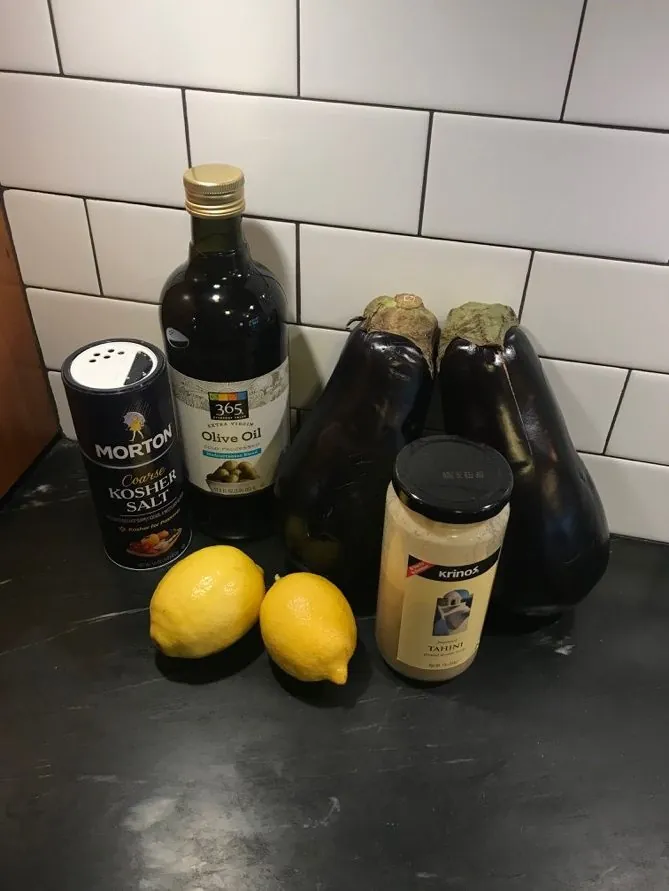
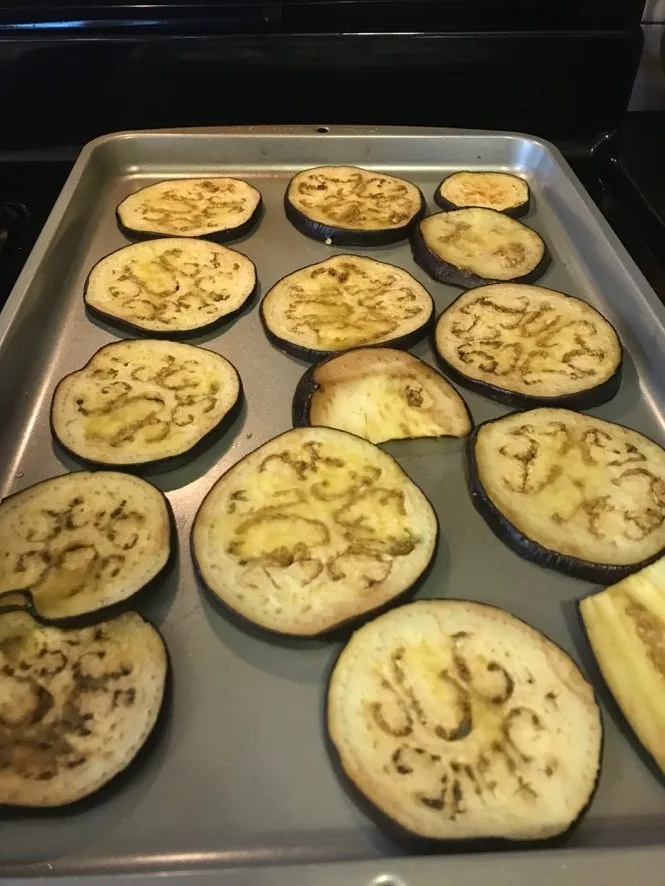

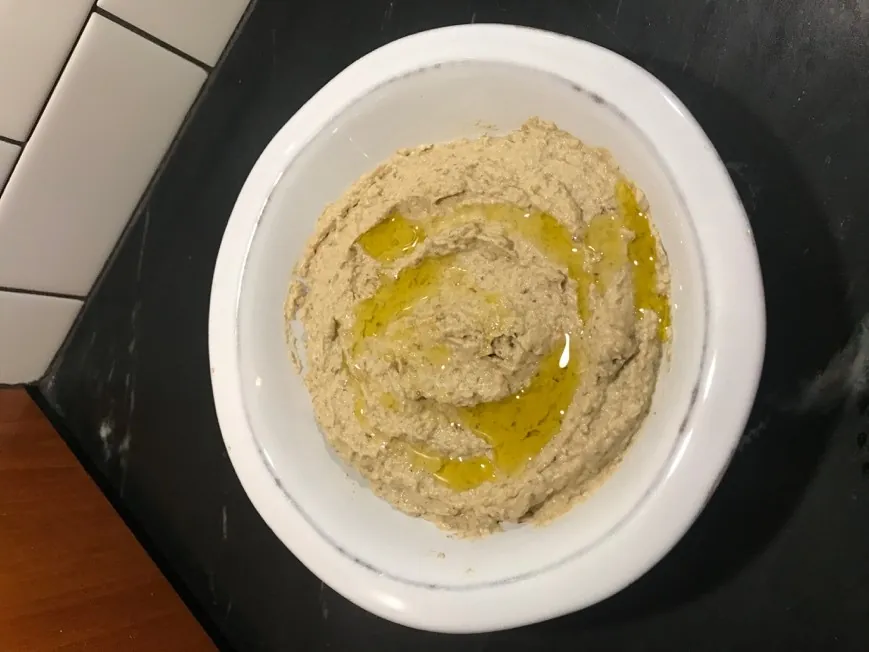
Roasted Red Pepper Dip
Ingredients:
- 3 red bell peppers
- 1 cup walnuts
- ½ cup fine breadcrumbs
- 3 tbsp extra-virgin olive oil
- 1 tbsp tahini
- 1 tsp lemon juice
- ½ tsp paprika
- Red chili flakes (to taste)
- Salt (to taste)
Directions:
- Preheat oven to 350 degrees
- Toast walnuts on a baking sheet for 8-10 minutes, flipping halfway through
- Let walnuts cool and set aside
- Change oven temperature to high broil and make sure the top rack is ready for broiling
- Cut peppers in half and remove seeds, ribs, and stem
- Place peppers on a baking sheet and put it the broiler for 12-15 minutes, flipping halfway through (It’s preferred if the skin is VERY charred because it is easier to remove the skin afterward)
- Once done, immediately place the peppers in a medium bowl and cover with plastic wrap
- Let the peppers stay in the bowl for 10 minutes to steam and finish cooking
- Transfer them to a cutting board and peel the skins off (it’s okay if a little doesn’t come off)
- Transfer peppers to blender
- Add walnuts, breadcrumbs, olive oil, tahini, lemon juice, paprika, red chili flakes, and salt
- Blend until smooth and transfer to a bowl
- Drizzle olive oil and extra walnuts on top for serving
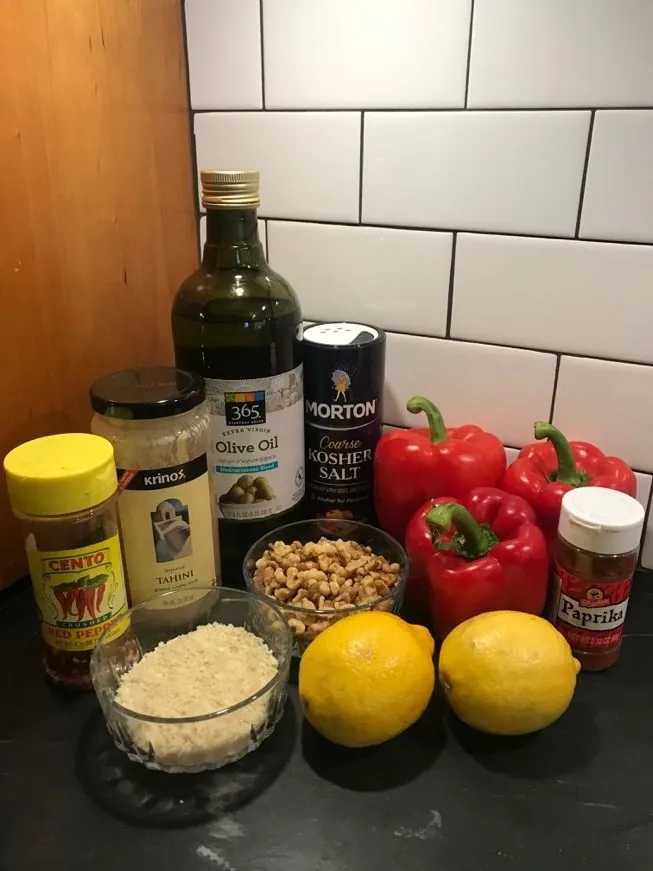
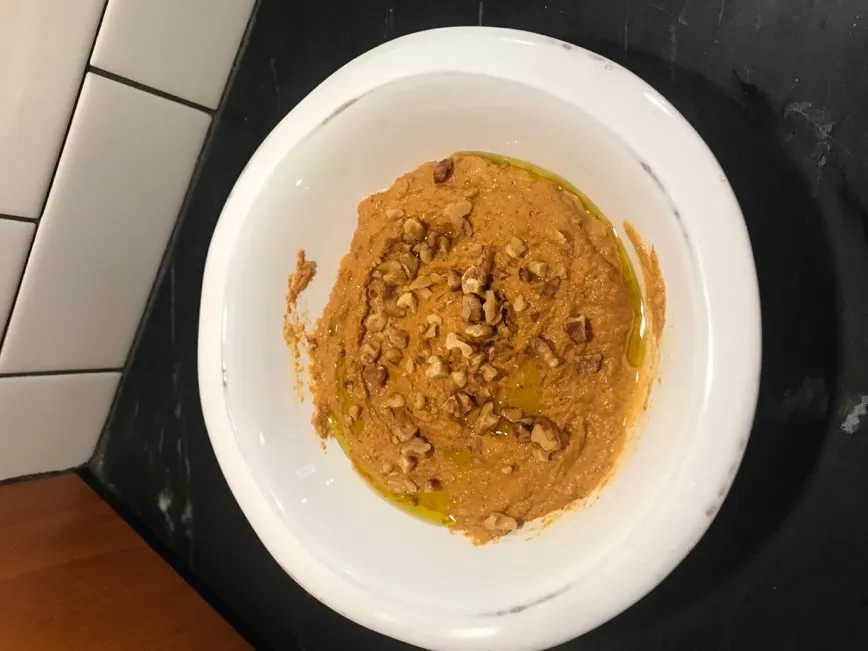
Benefits of Eggplant:
- Nutrient-dense food with low calories
- Full of fiber, potassium, manganese, folate, protein, vitamin K, and vitamin C
- High in antioxidants
- May reduce risk of heart disease
- May help reduce blood sugar levels (the high fiber content allows it to pass through the digestive tract intact)
- May aid in weight loss
- May have cancer-fighting benefits
- Easy to add to your diet
Benefits of Bell Peppers:
- Offers vitamin C, vitamin B6, vitamin K1, potassium, folate, vitamin E, and vitamin A
- Rich in antioxidants, especially carotenoids
- May aid in eye health
- Protect the retina from oxidative damage
- Lowers the risk of acquiring cataracts and macular degeneration
- May help lower risk of visual impairment
- Reduces risk of anemia
For more recipes head over to Fill Your Plate, we have hundreds to choose from!
References
Arnarson, A. (2019). Bell Peppers 101: Nutrition Facts and Health Benefits. Healthline. Retrieved from https://www.healthline.com/nutrition/foods/bell-peppers.
Link, Rachael. (2017). 7 Surprising Health Benefits of Eggplants. Healthline. Retrieved from https://www.healthline.com/nutrition/eggplant-benefits.
Benefits of Artichokes
By Sarah Beleski a recent ASU Nutrition Student
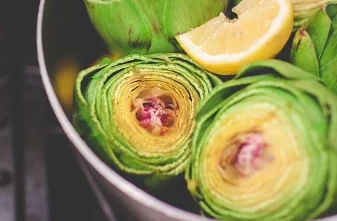
I’m going, to be honest… I had never even heard of artichokes until I was in high school. Fortunately, I have good old Applebee’s to thank for introducing me to the wonder that is spinach and artichoke dip. But that’s not all that artichokes are good for!
This highly underrated thistle, often confused as a vegetable, boasts many benefits! Artichokes are surprisingly very nutrient-rich. They are full of fiber, protein, vitamin C, vitamin K, thiamine, riboflavin, niacin, vitamin B6, folate, iron, magnesium, phosphorus, potassium, calcium, and zinc. One medium artichoke is approximately only 60 calories and includes 7 grams of fiber and 4 grams of protein. They also are low in fat and extremely rich in antioxidants.
An interesting point about artichokes is its potential to have beneficial effects on liver health. Many studies have been conducted that test artichoke leaf extract and its effects. Studies conducted with animals have shown that the extract has the potential to protect the liver and even possibly help the liver cells to regenerate. Another study involving 90 people with the non-alcoholic fatty liver disease showed similar results. The participants took 600 mg of artichoke extract every day for two months. The results of the study showed that the participants had improved liver function after the two months of artichoke consumption.
Artichokes may also improve digestive health. Its high fiber content helps everything in the digestive system to move smoothly. It also makes you feel full for a longer period of time, potentially eliminating overeating. One specific fiber that is found in artichokes is known as inulin and it works as a prebiotic. This prebiotic has been known to aid in improving gut bacteria. One study showed that 12 adults, who all consumed artichoke extract for three weeks, had an improvement in the bacteria of their gut at the end of the study.
According to the Journal of Clinical Biochemistry and Nutrition, artichokes may also have cancer-fighting elements. Artichokes contain flavonoid apigenin, which is a plant nutrient that may be able to help fight breast and pancreatic cancer cells.
Now, you might be trying to mentally calculate how much spinach and artichoke dip you would have to consume in order to reap these benefits, or maybe it’s just me, but unfortunately… that’s not the healthiest option. However, artichokes aren’t exclusive to spinach and artichoke dip (even if my high school self would have sworn it was true). There are many different ways that artichokes can be incorporated easily into your diet.
Here are some recipes to try out:
- Stuffed Artichokes
- Shrimp, Artichoke, and Fresh Ricotta Flatbread
- Braised Baby Artichokes
- Asparagus, Artichoke, and Mushroom Sauté with Tarragon Vinaigrette
- Orzo with Artichoke Pesto and Grilled Corn
- Chicken Piccata with Lemon, Capers and Artichoke Hearts
- Quick Artichoke Salad
- Spring Green Risotto with Artichokes
- Grilled Artichoke Sub
- Grilled Artichokes with Creamy Champagne Vinaigrette
Looking for fresh produce? Fill Your Plate has your back check our searchable database for farmers markets near you!
References
Brown, M.J. (2019) Top 8 Health Benefits of Artichokes and Artichoke Extract. healthline. Retrieved from https://www.healthline.com/nutrition/artichoke-benefits.
Miller, M. (2019) 10 Artichoke Health Benefits You Def Want to Get in On. Women’s Health. Retrieved from https://www.womenshealthmag.com/food/a25951695/artichoke- health-benefits/.
Salem, M.B., Affes, H., Ksouda, K., Dhouibi, R., Sahnoun, Z., Hammani, S., Zeghal, K.M. (2015) Pharmacological Studies of Artichoke Leaf Extract and Their Health Benefits. Plant Foods for Human Nutrition, 70, 441-453.

